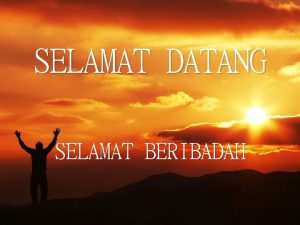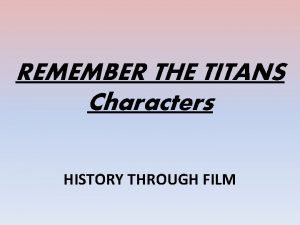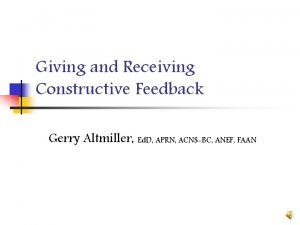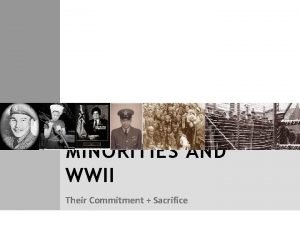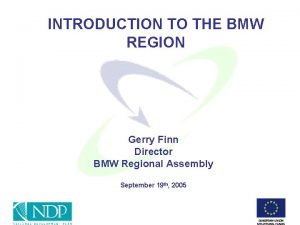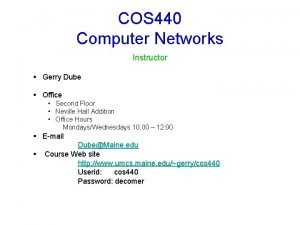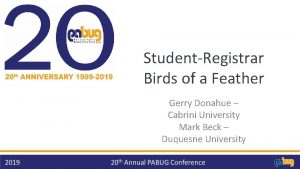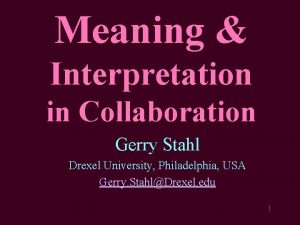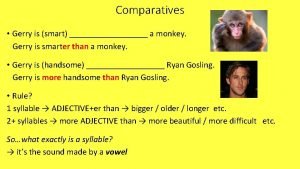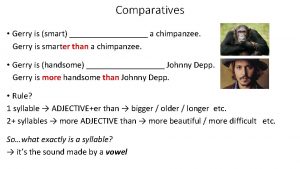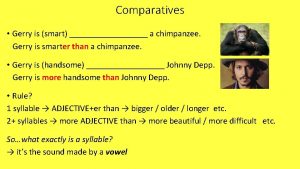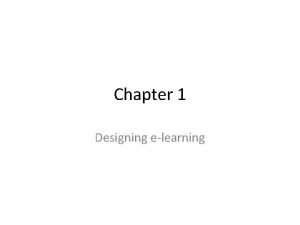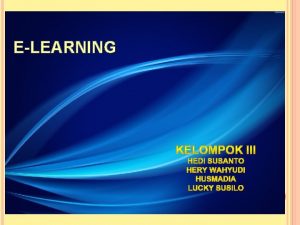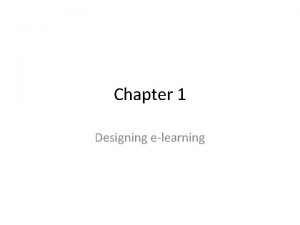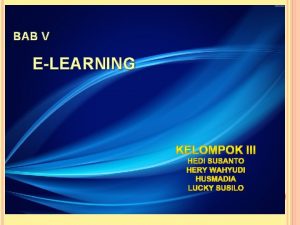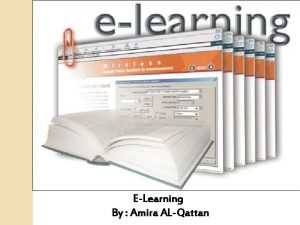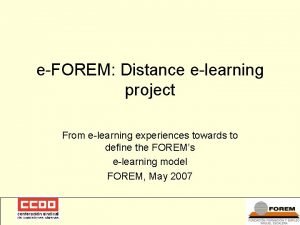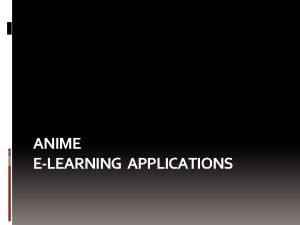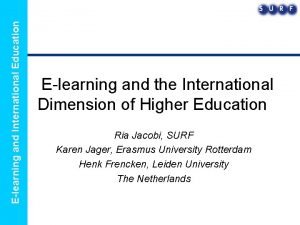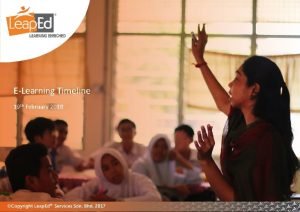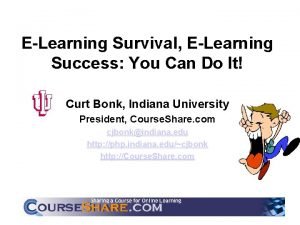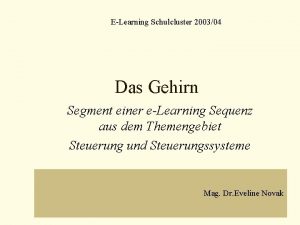the future of computer support for elearning Gerry





















![Heidegger: “Situation” • “Zum Beispiel mit diesem Zuhandenen [“artifact”], das wir deshalb Hammer nennen, Heidegger: “Situation” • “Zum Beispiel mit diesem Zuhandenen [“artifact”], das wir deshalb Hammer nennen,](https://slidetodoc.com/presentation_image_h/99634446da7b61e12ef26d3e67c6073c/image-22.jpg)































- Slides: 53

the future of computer support for e-learning Gerry Stahl Drexel University, Philadelphia, USA Gerry. Stahl@Drexel. edu 1

• A research agenda for the future based on past experiences: 4 example attempts to support e-learning led to the need to: • Focus on supporting group interaction • Develop a theory of collaboration • Extend & revise methodologies of software design (software as artifact & world -opening) • Envision the potential of e-learning in the future: supporting both group meaningmaking & individual interpretation 2

Overview • I. Attempts at computer support for e-learning • II. A shift of scientific paradigms • III. Implications for methodologies of designing computer support for e-learning • IV. A potential future for e-learning • V. Open questions and challenges 3

Returning what I learned from Germany • My Ph. D in philosophy: • 1967/68 Heidelberg – Heidegger, Gadamer • 1971/73 Frankfurt – Hegel, Marx, Adorno, Habermas • Importance of theory & its historical development • My Ph. D & research in computer science: • 1989 -01 Colorado – Gerhard Fischer L 3 D, visitors, AI • Situated cognition & support for communities of practice • Visiting scientist: • 2001/02 GMD/Fraunhofer FIT – W. Prinz, W. Appelt, EU ITCOLE (BSCL software) • Collaborative design to support CSCW in practice 4

Part I. Attempts at computer support for e-learning • Web. Guide: interpretive perspectives on meaning – collaboration with Th. Herrmann (Dortmund), NOAA, teacher • Sim. Rocket: making learning visible in discourse – collaboration with communication, psychology & anthropology profs, teachers & students • BSCL: negotiating system design – EU project with designers & pedagogy profs in Germany, Spain, Finland, Greece, NL, Italy • Virtual Math Teams: creating collaborative worlds – collaboration with online Math Forum, international CSCL 5

Web. Guide: interpretive perspectives on meaning • Threaded discussion system that displayed discussion items in different selections • Personal, team and class perspectives: – The class only included shared, agreed upon ideas – The team perspective included ideas that the team was working on as well as class ideas – The personal inherited class & team ideas, but could edit, add to and re-organize them: personal interpretation of shared meaning 6

Supporting collaborative interactions: divergent & convergent group thinking 7

Sim. Rocket: making learning visible in discourse • Simulation of rocket launches for 8 different rockets with different characteristics • Student task was to determine best characteristics through experimental analysis • Study of digital video of student interactions revealed how the group solved its task and collaboratively learned practices that none of the students knew 8

Discourse about Sim. Rocket • • • • 1: 22: 05 1: 22: 06 1: 22: 08 1: 22: 09 1: 22: 10 1: 22: 11 1: 22: 12 1: 22: 13 1: 22: 14 1: 22: 15 1: 22: 16 1: 22: 17 1: 22: 18 1: 22: 19 Brent Jamie Chuck Steven Chuck Jamie Brent Chuck Jamie Chuck Brent Jamie Chuck This one’s different Yeah, but it has same no… Pointy nose cone Oh, yeah But it’s not the same engine Yeah, it is, Yes it is, Compare two n one Number two I know. Are the same Oh It’s the same engine. So if you compare two n one, Oh yeah, I see, I see • From Sim. Rocket transcript 9

BSCL: negotiating system design • “Basic System for Collaborative Learning” is based on BSCW • Includes threaded discussion, chat, whiteboard in areas for personal, team and class knowledge-building • Supports team negotiation of ideas; promotes agreed to ideas from team to class perspective 10

BSCL • Teams of students at Drexel used BSCL, analyzed logs of their usage, designed functionality to support problematic interactions, negotiated group design proposals 11

Virtual Math Teams: creating collaborative worlds • New research project at Drexel University • Extend Math Forum (www. mathforum. org) online “problem of the week” • Students who visit the site are invited into small teams to solve math problems collaboratively • Structured, mentored problems are done in e-learning environment • Logs are analyzed to study group learning • Creates virtual teams from a 1, 000 person global community to collaborate in a new environment doing a new activity 12

Results of attempts to support e-learning • Web. Guide: knowledge building goes through various processes, like divergent brainstorming & convergent negotiation; need to support collaborative interactions • Sim. Rocket: knowledge is constructed by the group – not just transferred from individual to individual; users must learn the social practices embedded in their software • BSCL: software design requires many iterations of trial in group usage; users must learn the meanings & affordances embedded in their software’s design • Virtual Math Teams: new opportunities for educational group interaction can be designed with software that opens new shared worlds 13

• From Part II. A shift of scientific paradigms – AI in Ed to – Augmented cognition, communication (ICT) • From – Human <-> computer (HCI) to – Human <-> human via computer (CSCW) • From – Individual psychology (pre/post tests; stats) – Group interaction (qualitative communication patterns) • From – Computer science as engineering – Interaction design, situated cognition, activity theory 14

Problems with the focus on individuals • Computer science problem: software is designed for individuals, not group interactions • Education problem: learning is conceived as in individual minds, not social interaction • Philosophy problem: focus on individual thinker, not social actor • Political problem: George W. Bush as cowboy entrepreneur: an “ideology of individualism, ” not the EU “spirit of collaboration” 15

Need for a theory of collaboration • Software development experiences • Shifts in the academic field • Other problems with individual focus • Research on collaboration theory • Back to roots in German philosophy 16

Philosophy of the individual • Greeks stressed role of individual (e. g. , Odysseus – Adorno & Horkheimer) • Descartes stressed individual mind • German philosophy critiqued Descartes: – – Kant: “Copernican revolution” Hegel: social history of mind Marx: social basis of ideologies Wittgenstein: meaning in use, not in mental propositions – Heidegger: tacit understanding, artifacts, situated-ness, Mit-da-sein, Ereignis – Habermas: communicative action 17

Philosophies of the group • Vygotsky: physical, symbolic, cognitive artifacts from shared culture • Sachs: conversation analysis • Garfinkel: ethnomethodology • Lave & Wenger: situated learning & social practice & communities of practice • focus on: tacit practices, discourse, shared culture, non-mentalist 18

Individualist & social philosophies & theories of learning Descartes (1633) Cognitivist Instructionism Rationalism Empiricism Kant (1787) Evidence-Based Instructionism Piaget Wittgenstein Husserl Wittgenstein social theories Conversation Analysis Situated Cognition Habermas Communicative Action Heidegger (1927) Marx (1867) individual theories Ethnomethodology Schutz Hegel (1807) Constructivism anthropology Vygotsky (1934) Social Practice Activity Theory 19

The philosophy of Martin Heidegger • Systematic re-thinking of human understanding & activity as a critique of Descartes & the Western tradition • Has its own political & theoretical problems • But, provides the root of many new theories • And, has untapped fertile approaches 20

Heidegger on artifacts • As applied to HCI by Winograd/Flores, Dreyfus, Suchman, Ehn & Budde/Züllighoven, Heidegger distinguished things that are explicitly present to us from artifacts that are tacitly at hand. • Explicit knowledge of things is only possible on the basis of a wealth of tacit knowing, skills and practices. • To know is to have a practical ability to do something in certain situations, not primarily to have stored propositions or mental representations that correspond to things present in the world. 21
![Heidegger Situation Zum Beispiel mit diesem Zuhandenen artifact das wir deshalb Hammer nennen Heidegger: “Situation” • “Zum Beispiel mit diesem Zuhandenen [“artifact”], das wir deshalb Hammer nennen,](https://slidetodoc.com/presentation_image_h/99634446da7b61e12ef26d3e67c6073c/image-22.jpg)
Heidegger: “Situation” • “Zum Beispiel mit diesem Zuhandenen [“artifact”], das wir deshalb Hammer nennen, hat es die Bewandtnis beim Hämmern, mit diesem hat es seine Bewandtnis bei Befestigung, mit dieser bei Schutz gegen Unwetter; dieser >ist< um-willen des Unterkommens des Daseins, das heisst, um einer Möglichkeit seines Seins willen. Welche Bewandtnis es mit einem Zuhandenen hat, das ist je aus der Bewandtnisganzheit [“Situation”] vorgezeichnet. ” Heidegger, Sein und Zeit. S. 84 22

Heidegger: “Mitsein” • “Auf dem Grunde dieses mithaften In-der-Welt-seins ist die Welt je schon immer die, die ich mit den Anderen teile. Die Welt des Daseins ist Mitwelt. Das In-Sein ist Mitsein mit Anderen. ” Su. Z § 26 • At this point in his analysis, Heidegger overcomes the tradition of individualistic philosophy and can analyze situated meaning and language as based in the community 23

Heidegger on Being-with • But in the next section of Sein und Zeit, Heidegger rejects the social basis of human being in favor of an “authentic” stance of the individual toward his own finitude as the basis of meaning. • Adorno, in his Jargon of Authenticity, tied this move to a politically conservative ideology. • One can see this as a source of Heidegger’s political problems, as well as his philosophical problem of not understanding the social basis of phenomena like language and history. 24

Heidegger: “Welteröffnung” • “Van Goghs Gemälde ist die Eröffnung dessen, was das Zeug, das Paar bauernschuhe, in Wahrheit ist. Dieses Seiende tritt in die Unverborgenheit seines Seins heraus. . Im Werk ist, wenn da eine Eröffnung des Seienden geschieht, in dem was und wie es its, ein Geschehen der Wahrheit am Werk. ” Martin Heidegger, Der Unsprung des Kunstwerkes in Holzwege (Frankfurt: Klostermann, 1963), S. 25

Heidegger on opening shared worlds • “Sculpture: an embodying bringing-into-work of places and with this an opening up of realms of possible living for men, of possible persisting for the things which surround and concern men. ” Martin Heidegger, Raum und Kunst (St. Gallen: Erker Verlag), 1969), S. 13 26

Vygotsky applies German philosophy to learning • We use tools (physical artifacts) to do things in the world. They mediate & transform our tasks • We use words (and other symbolic artifacts) to interact with others and to control ourselves • We learn to use these artifacts in interaction with other people. • We often internalize these artifacts for use silently to ourselves, developing sets of cognitive artifacts – which supplement, vastly extend and transform our biological mental skills like memory, attention • Learning takes place primarily through interaction and discourse 27

The focus on interaction in social science • Harvey Sachs, Lectures on Conversation, interprets interaction without speculating on participant’s thoughts, feelings, motivation • Harold Garfinkel, Studies in Ethnomethodology, analyzes unique events as community members interactively accomplishing tasks by negotiating methods • Lave & Wenger describe learning as increasing one’s centrality in a community of practice • Such approaches focus on tacit skills, social practices, discourse and shared culture rather than explicit propositional knowledge or mental representations 28

Unit of analysis Individual Collaborative group Meaning-making Meaning is in individual minds Meaning is shared, social, cultural Knowledgebuilding Explicit propositions are primary Tacit practices are foundational Communication model Transmission from mind to mind Interactive construction Education model Transmission of Co-construction in propositional discourse knowledge from expert teacher to blank slate student 29

Interpretation as synthesis of individual and group • Artifacts (linguistic, physical, practices) embody, store, transmit shared meanings • We are born into a meaningful world of language, artifacts, social practices, habits, culture – which we must learn to understand (Heidegger hermeneutics) • We interpret meanings based on our pre-understanding (Vygotsky “Zone of Proximal Development”) • Our activity is situated in activity context, shared world, personal perspectives • Meanings are shared, in-the-world, socially created in collaboration; individuals interpret the meanings from their personal perspectives, tacit pre-understanding – G. Stahl, Meaning and Interpretation in Collaboration, CSCL ’ 03. 30

Part III. Implications for methodologies of designing computer support for e-learning • Need new methods corresponding to a focus on group interactions rather than individual mental representations: – Theoretical framework, theory of collaboration – Analytic method, to analyze support needs – Design approach, to develop software – Evaluation technique, to assess software & 31 supported interactions

Theoretical framework • Need a theory of collaboration • Group as primary unit of analysis • Avoid mentalist assumptions, hypotheses, speculation about motivations & plans • Central role of artifacts (tools, language, software, cognitive skills) • Mind as social construct – developed in interaction by internalizing tools and practices • Web. Guide supports group interactions with individual and group perspectives, allowing for a hierarchy of groups & sub-groups. Also provides comparison & negotiation perspectives 32

Analytic method • Need a methodology for analyzing the processes of e-learning that need to be supported. • Conversation analysis of logs • Analysis of interaction structures and common patterns • Break-down & problems reveal interaction needs • Micro-analysis of content of logs and digital video can reveal learning as it takes place in a group • Sim. Rocket usage was analyzed with conversation analysis of digital video, showing how a group repaired divergent interpretations and achieved basic scientific practices as a group 33

Design approach • Need an approach to designing e-learning software. • Instead of viewing e-learning software as a neutral transmission service for explicit knowledge: – Software as artifact • Embodies meaning & designed practices • Requires learning to use and interpret • Transforms practices – Software as medium • Limits types of content • Enables certain types of interactions – Software as opening worlds • Creates new opportunities • Brings people together in new communities • Defines new social practices • Virtual Math Teams is being designed by observing student teams interacting F 2 F and online, under different conditions of group composition and software support. Break-downs of interaction will indicate what functionality is needed. Question 34 is: how to open & structure new worlds for interaction; what kinds of breakdowns are likely

Evaluation technique • Need methodology for evaluating the success of e-learning software in supporting effective group knowledge-building. • Lab studies are very limited – focus on isolated individual out of learning situation • Quantitative studies miss nuances & content of learning interactions • Need to design software, tasks, content, groups, settings to produce learning interactions (design studies) • Unique case studies are not replicable, but also not anecdotal; they reveal generalizable patterns and learning possibilities • BSCL has been evaluated in European schools using interviews without significant findings. Evaluation by teams of HCI students using it in design studies at Drexel found many weaknesses and proposed many improvements 35

Individualist approach Collaborative approach Software example Theoretical Psychological Collaborative model of group Web. Guide cognition; situation-, artifactframework model & group-centric Discourse analysis & analyze practices (not mental reps); make knowledge-building visible; unique cases; structures of interaction; patterns Analytic method Algorithmic, analytic Design approach Specifications Shared-world creating; media Virtual & environments for human Math social interaction; software as Teams artifact Evaluation Quantitative technique laboratory studies Reflective discourse; design studies Sim. Rocket BSCL 36

Part IV. A potential future of e-learning • Find & form collaborations with special people anywhere, anytime • Form non-hierarchical, non-moderated collaborations • Form global networks of collaborations • Build communities with micro-structure • Invent new ways of learning & new tools to support collaboration & learning 37

e-learning & cognitive development • Another quantum jump in artifact-cognition: – Physical artifacts: tools – Symbolic artifacts: language – Cognitive artifacts: internalization – Persistent artifacts: inscription (writing, drawing) – Ubiquitous artifacts: mechanical reproduction – Digital artifacts: computers – Collaborative artifacts: networked computers & e-learning 38

Theory • We can build on existing socio-cultural theory • There is a rich socio-cultural theory tradition with a continuous history (in Germany) of over 200 years (at least) • This tradition has strong roots in the mainstreams of 20 th century philosophy & theory: Marx, Heidegger, Wittgenstein • But, we need to apply this theory to collaboration, e-learning, software design 39

Analysis • We can analyze the nature of collaboration using a strong definition of “collaboration: ” • group meaning-making (not just incidental interaction of individual meaning makers) • Meaning is constructed in discourse by groups; analyze meaning-making at group unit of analysis as in Sim. Rocket transcript • Meaning must be interpreted by involved individuals from their situated perspectives • Software should support these meaning-making interactions • Collaborative learning is foundational, not secondary 40

Design • In order to design for collaborative interactions: – Design software as a mediating artifact – not an explicit, visible interface – Or as a medium of communication & interaction – Or as the opening of a new shared world 41

Evaluation • Design so new learners will learn the meanings and practices embodied in the software • This may mean designing more than software: content, use scenarios, minicurricula, social practices, guidance for usage, etc. 42

Part V. Open questions & challenges • e-Learning – in order to get started – had to use the ideas, tools & approaches inherited from an era focused on the individual • Now it is time to rethink our theory, pedagogy, analytic methods & technologies with a focus on groups & collaboration • A conference in Germany is a fitting starting point to move away from the philosophy of individualism (something harder to do in America these days) • I have just tried to pose questions and a research agenda, not to provide complete arguments, theories or methodologies – that is something I hope we will work on collaboratively in the future 43

Theory questions – Should we define “collaboration” as joint meaning-making by a group or community? – A model of collaboration; typical processes? – Relation of individual thought to social meaning-making: • Internalization (Vygotsky)? • Personal interpretation? – How can we reach a dialectical synthesis (Aufhebung) of the philosophies of individual cognition & group interaction? – We need a theory of collaboration & pedagogy of collaborative learning 44

Analysis questions • Can conversation analysis be made into a technique for practical e-learning design? • How to gather requirements when users are novices, virtual, groups, not-yet-identified? • Are requirements unique to situations, activities, communities? 45

Design questions • Use of lab tests, measurements versus situated usage by groups? • Software as artifact with affordances? • Software as medium for communication? • Software as opening worlds? • Participatory design? • Design lifecycle, design by evolution? 46

Evaluation questions – Combining quantitative & qualitative results? Do quantitative point to issues for investigation or qualitative descriptions point to hypotheses? – Generalizability of case studies? Analysis of interaction structures in unique cases? – Assessment of learning – by group or by individuals? Over time periods? – What forms of learning are appropriate for elearning? For collaborative learning? For individual instruction? 47

Concluding questions for future e-learning software • How can we support collaborative interactions within groups learning together? • How can software open up new worlds of collaboration and learning? • How will new users discover the meanings and practices embodied in software? 48

E-learning about e-learning • How can we use e-learning technology to answer these questions? • This conference may be an important step! • What can be done to foster collaboration between conferences? 49

Gerry Stahl Drexel University, Philadelphia, USA Gerry. Stahl@Drexel. edu my papers on e-learning: http: //www. cis. drexel. edu/faculty/ gerry/cscl/papers 50

Heidegger on “situation” • “For example, the artifact at hand which we call a hammer has to do with hammering, the hammering has to do with fastening something, fastening has to do with protection against bad weather. What significance artifacts have is prefigured in terms of the situation as a totality of relationships of significance. ” Heidegger, Sein und Zeit. 51

Heidegger on Being-with • “On the basis of this being-in-the-world with others, the world is always the world which I share with others. The world is always the shared world. Being in the world is being there with others. ” Su. Z § 26. • At this point in his analysis, Heidegger overcomes the tradition of individualistic philosophy and can analyze situated meaning and language as based in the community. 52

Heidegger on opening shared worlds • “Van Gogh’s painting is an opening-up of that which the artifact, the pair of farmer’s boots, in truth is. This being moves into the unconcealment of its being. . There is a happening of truth at work in the work, if an opening-up of the being takes place there into that which and that how it is. ” Martin Heidegger, Der Unsprung des Kunstwerkes in Holzwege (Frankfurt: Klostermann, 1963), S. 25. 53
 Future perfect and future continuous exercises
Future perfect and future continuous exercises Future simple continuous perfect
Future simple continuous perfect Khotbah gerry takaria
Khotbah gerry takaria Petey jones remember the titans character
Petey jones remember the titans character Gerry altmiller
Gerry altmiller Gerry cobb pritzker
Gerry cobb pritzker Gerry lawlor
Gerry lawlor Gerry firmansyah
Gerry firmansyah Cree language
Cree language Gmacfoa
Gmacfoa Gerry finn
Gerry finn Cos 440
Cos 440 Gerry schwab
Gerry schwab Hurry present perfect sentence
Hurry present perfect sentence Cid 610
Cid 610 Gerry davis stance
Gerry davis stance Cabrini registrar
Cabrini registrar Stahl meaning
Stahl meaning Charge pump basics
Charge pump basics Grammatical signals examples
Grammatical signals examples Future perfect presentation
Future perfect presentation Simple present simple past simple future
Simple present simple past simple future Future continuous.
Future continuous. Future nurse future midwife
Future nurse future midwife Past future continous tense
Past future continous tense Travel future continuous
Travel future continuous Verbal times
Verbal times Future plans and finished future actions
Future plans and finished future actions Future continuous
Future continuous Kondicional engleski
Kondicional engleski Kontinuitetshantering i praktiken
Kontinuitetshantering i praktiken Typiska drag för en novell
Typiska drag för en novell Nationell inriktning för artificiell intelligens
Nationell inriktning för artificiell intelligens Vad står k.r.å.k.a.n för
Vad står k.r.å.k.a.n för Varför kallas perioden 1918-1939 för mellankrigstiden
Varför kallas perioden 1918-1939 för mellankrigstiden En lathund för arbete med kontinuitetshantering
En lathund för arbete med kontinuitetshantering Kassaregister ideell förening
Kassaregister ideell förening Personlig tidbok
Personlig tidbok Anatomi organ reproduksi
Anatomi organ reproduksi Förklara densitet för barn
Förklara densitet för barn Datorkunskap för nybörjare
Datorkunskap för nybörjare Boverket ka
Boverket ka Hur skriver man en tes
Hur skriver man en tes Delegerande ledarstil
Delegerande ledarstil Nyckelkompetenser för livslångt lärande
Nyckelkompetenser för livslångt lärande Påbyggnader för flakfordon
Påbyggnader för flakfordon Kraft per area
Kraft per area Svenskt ramverk för digital samverkan
Svenskt ramverk för digital samverkan Jag har gått inunder stjärnor text
Jag har gått inunder stjärnor text Presentera för publik crossboss
Presentera för publik crossboss Jiddisch
Jiddisch Kanaans land
Kanaans land Klassificeringsstruktur för kommunala verksamheter
Klassificeringsstruktur för kommunala verksamheter Mjälthilus
Mjälthilus


